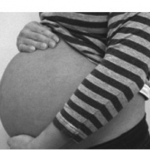Well there we were in Kingston hospital with the Sonographer when my husband and I heard the big news…’it’s not one but two babies’. The news slowly sunk in and from that moment on I began to notice double buggies and larger than normal pregnant bellies.
As a physiotherapist, I had an acute awareness of the changes in my body. Unfortunately, I was unlucky enough to have terrible morning, or rather all day and evening, sickness throughout my pregnancy that made a social life rather impossible and meant I was generally a shade of green and often clutching airplane sick bags and a bowl!
I found being a member of Twinsclub a life saver and clearly remember the huge feeling of support I felt when I got 13 replies to a question I posted on the site to ask for weaning tips after one too many challenging and unrewarding mealtimes!
As a thank you to Twinsclub I would like to share some tips for expectant and new mothers of twins, from a physiotherapy perspective.
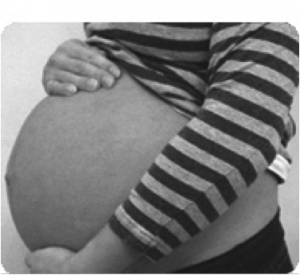
During your pregnancy:
Even though your belly is expanding you can still activate your pelvic floor and abdominal muscles and continue to exercise unless you have been advised otherwise. It is not generally the best time to take up a completely new activity! Pilates and pregnancy yoga are excellent ways to stay in shape! It is also good to do some cardio-vascular exercise if you can.
Postural care is extremely important during pregnancy.
Standing posture:
As your bump grows, your centre of gravity moves forwards and the pelvis tends to tilt forwards. As a result, many new mothers tend to adopt this position or over correct so they flatten their low back too much. It can really help to stand side on to a mirror and check your weight is evenly placed throughout each foot, knees are not locked back but softly bent and your hips are centered over your anklebones.
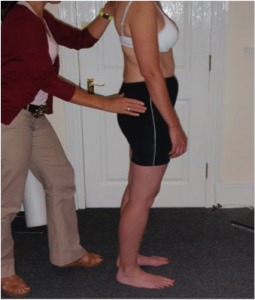
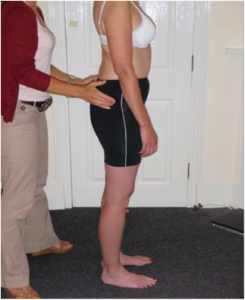
Sitting posture:
When sitting it is helpful to avoid crossing your legs to avoid compromising your circulation and sitting on an upright chair. The spine is an ‘S’ shape and this is the optimum position for it to be in – see pictures. A rolled up towel or small cushion placed at the base of the spine across the dimples of your low back can really help.
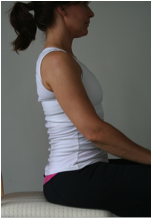
When you are buying kit for your new babies I would suggest you consider the following points: Buggies – it is helpful to choose one with an adjustable handle so you can stand tall when you push the buggy.
- Breastfeeding cushions – can be useful before your babies arrive at night to support your belly and go between your legs to reduce pelvic rotation. They can also be a useful footrest
- Changing tables – try to use a high table if you can so that you do not need to bend over every time you change a nappy – 20 to 25 nappy changes a day were our record and I assure you it is worthwhile to be comfortable! Baby baths – a baby bath that fits across the sides of the bath rather than sitting in the bath, avoids excessive bending.
Once the twins have arrived:
- When feeding: Make sure you have a supportive chair or sofa to sit on when you are feeding your twins. Remember to achieve the ‘S’ shape mentioned above. Pillows or a breastfeeding cushion helps to ensure your twin(s) (depending on whether you are feeding one or both at a time), are high enough so you do not have to flex your spine to allow them to latch on. Remember cushions compress so you may need more padding than you initially think to avoid sinking down as you feed! Your shoulders should be relaxed and your arms gently supporting your twin(s) as they feed rather than gripping on to them to stop them rolling away from you. This may take quite a bit of trial and error to perfect but it is well worth the effort.
- When lifting your babies and holding them: As you lift your babies, engage your pelvic floor first as this will also activate your deep abdominal muscles. Try to resist the temptation to sway your hips forward and hang on both or one hip. This switches off your gluteal or buttock muscles and low abdominals and means your low back and pelvis are unsupported!
When pushing the buggy:
This is a great opportunity to get some fresh air, exercise and really improve your fitness. Remember though however tired you may be feeling after countless disturbed nights, not to slouch forward and bend over the buggy as you push! It is not only very bad for you to do this but also highly unattractive! Walk tall and make sure you are upright! If you can it is really helpful to engage your pelvic floor muscles and low stomach muscles by gently contracting them as you walk. It really helps if you can buy a buggy with an adjustable handle so you can ensure it is the correct height for you.
Putting car seats in the car:
I am afraid there is not really an easy way to do this! Keeping the seat as close to you as possible and bending your knees if you have a low car at least helps to reduce some of the strain. It also is a good idea to tighten your pelvic floor and low abdominals to support your spine and pelvis. It may seem a tall order to do this at the same time but if you start consciously doing this it will become automatic in time.
Getting back in shape:
Time to yourself may seem a distant memory but if you can, it is really beneficial to resume your normal exercise routine. This will help you to feel better in both mind and body. I would emphasize that good posture and moving well throughout your day in general is extremely valuable and can really improve your muscle tone and appearance in general.
Finding your previous posture can take time. During pregnancy your centre of gravity moves forwards and the pelvis tends to tilt forwards so many new mothers tend to stay in this position or over correct so they flatten their low back too much. It can really help to stand side on to a mirror and check your weight is evenly placed throughout each foot, knees are not locked back but softly bent and your hips are centered over your anklebones.
Two areas that are particularly important to work on are the pelvic floor and the abdominal muscles:
The pelvic floor: The pelvic floor is under huge strain during any pregnancy let alone a twin pregnancy and after both vaginal or caesarian delivery can take time to recover. Many women suffer in silence. If you are having problems with your pelvic floor you may need to be referred to a women’s health physiotherapist for an assessment that may include examination of the pelvic floor.
The abdominal muscles: During pregnancy, as twins bumps are much bigger than singleton bumps, the abdominal muscles and pelvic floor are under extra strain. The rectus abdominus muscle, alternatively known as the ‘6 pack’ muscle, separates during pregnancy to allow extra space in the abdomen for the babies and you may be aware that your GP or midwife checked to see the degree of separation correction at your post natal check. Failure to achieve this correction can lead to a loss of abdominal stability and potentially lead to low back or pelvic problems in addition to a flabby tummy. Research has demonstrated that however long ago you had your babies that correct re-education of the abdominals can achieve correction.
If you would like more information about post natal exercises see our website: www.sprintphysio.co.uk under Women’s health. Our Women’s health physiotherapist and our team at Sprint Physiotherapy are very happy to answer any queries you may have by email: info@sprintphysio.co.uk or 020 7938 1350.
I hope the tips above will help you to feel healthier and more comfortable throughout your pregnancy and in the early years of your twins’ lives! Get £10 off your first session of either physiotherapy, pregnancy massage or Pilates if you mention that you are a Twinsclub member when booking an appointment. (This offer excludes patients using insurance policies to claim for physiotherapy treatment.)
By Camilla Curtis MSc Physiotherapy
Sprint Physiotherapy is based in Kensington, London, W8 4LY. © Sprint Physiotherapy 2011

